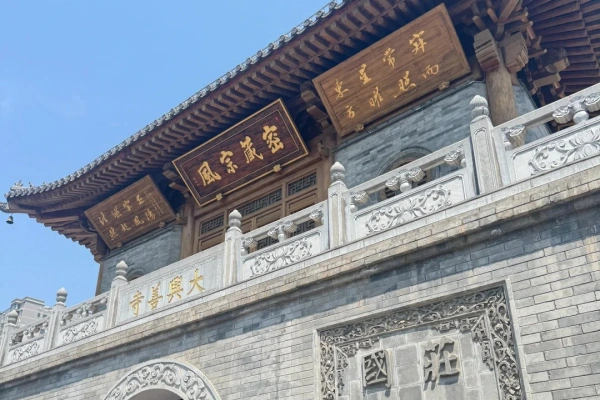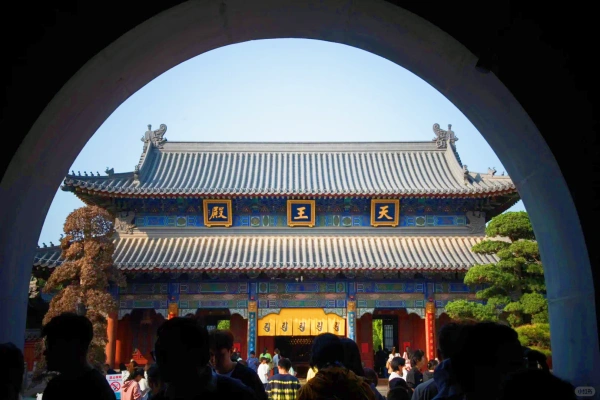Daxingshan Temple
Historical Overview
Daxingshan Temple’s history is woven into the fabric of Chinese Buddhism and dynastic legacy.
265 AD: Established as the "Zunsheng Temple" during the Western Jin Dynasty, serving as a center for Buddhist scripture translation.
618–907 AD: Renamed "Daxingshan Temple" under the Tang Dynasty, becoming a royal monastery and hub for pilgrims along the Silk Road.
1368–1644 AD: Ming Dynasty renovations added the iconic Three-Story Pagoda and expanded the main hall.
1956–1966 AD: Preserved as a cultural relic site, though parts suffered damage during the Cultural Revolution.
1983–Present: Restored by the government, designated a National Key Buddhist Temple, and revived as a center for Buddhist education and tourism.
Structural Layout
The temple’s layout follows traditional Chinese Buddhist architecture, with symmetrical courtyards and axial alignment.
Main Entrance Gate: A grand red archway adorned with golden Buddhist symbols, leading to the Bell Tower (housing a 2-ton Ming Dynasty bronze bell).
Main Hall (Daxiong Baodian): The central sanctuary, featuring a 5-meter-tall gilded statue of Sakyamuni Buddha, surrounded by 18 Arhats carved from camphor wood.
Three Story Pagoda: A 23-meter-tall brick pagoda built in 652 AD, with intricate carvings of Bodhisattvas and lotus motifs on each tier.
Meditation Hall: A quiet space with tatami mats and incense burners, used for daily prayers and mindfulness sessions.
Sutra Library: A repository of over 5,000 Buddhist scriptures, including rare Tang Dynasty woodblock prints and handwritten manuscripts.

Major Attractions
Three Story Pagoda: Climb the spiral staircase for panoramic views of Xi’an’s skyline and the temple’s courtyards.
Tang Dynasty Murals: Admire 14th-century frescoes in the East Hall, depicting scenes from the Lotus Sutra and celestial beings.
Jade Buddha Chamber: A modern addition housing a 1.5-ton white jade statue of Buddha, carved in Myanmar and donated in 2006.
Ancient Cypress Grove: A cluster of 1,000-year-old cypress trees, said to have been planted by Tang Dynasty monks, shading stone benches for reflection.
Suggested Itineraries
Classic Route (1–2 Hours): Main Entrance → Bell Tower → Main Hall (30 mins) → Three Story Pagoda (20 mins) → Sutra Library (15 mins). Highlights: Iconic pagoda, gilded Buddha statue, and historic murals.
Cultural Depth Route (2–3 Hours): Main Hall → Tang Murals Hall (40 mins) → Meditation Hall (30 mins) → Jade Buddha Chamber (20 mins) → Cypress Grove (15 mins). Highlights: Artistic heritage, meditation practice, and natural serenity.
All Day Exploration (Full Day): Morning: Classic Route + Tea Ceremony (1 hour, ¥80). Afternoon: Sutra Transcription Workshop (1.5 hours, ¥120) + Guided Tour of Hidden Courtyards (¥150). Evening: Evening Chanting Session (free, 6–7 PM). Highlights: Immersive cultural experiences and spiritual practices.
Ticket Purchase
Online: Book via the official WeChat account "Daxingshan Temple" (up to 3 days in advance).
On Site: Purchase at the ticket office near the Main Entrance (open 8 AM–5 PM).
Prices: Standard Entry: ¥30 (includes access to all halls and pagodas). Special Exhibitions: ¥50–100 (e.g., "Tang Dynasty Buddhist Art" temporary show). Guided Tours: ¥100–200 (1-hour English/Chinese tours). Free Admission: Children under 1.2m, monks in robes, and seniors over 70.

Transportation
By Subway: Line 2 or 3 to Xiaozhai Station (Exit D), then a 10-minute walk west along Xingqing South Road.
By Bus: Routes 5, 19, 21, 22, 23, 24, or 27 to "Daxingshan Temple" Stop.
By Taxi: Direct to "Dàxīngshān Sì" (大兴善寺) in Chinese.
Parking: Limited street parking nearby; recommended to use public transport during peak hours.
Best Time & Tips
Avoid Crowds: Peak Hours: 10 AM–2 PM (weekends/holidays). Best Times: 8:30 AM opening or after 3 PM (weekdays). Quietest Days: Tuesdays–Thursdays (Mondays open as usual).
Weather: Spring (March–May) and autumn (September–November) offer mild temperatures for outdoor exploration.
Essentials: Download the temple’s AR guide app for audio explanations of murals and pagodas. Wear modest clothing (covered shoulders/knees) out of respect. Stay hydrated; bring a reusable bottle (water stations available near the Sutra Library). Photography: Allowed everywhere except inside the Main Hall during prayers. Prohibited Items: Large backpacks, selfie sticks, and incense sticks (provided free at designated altars).

